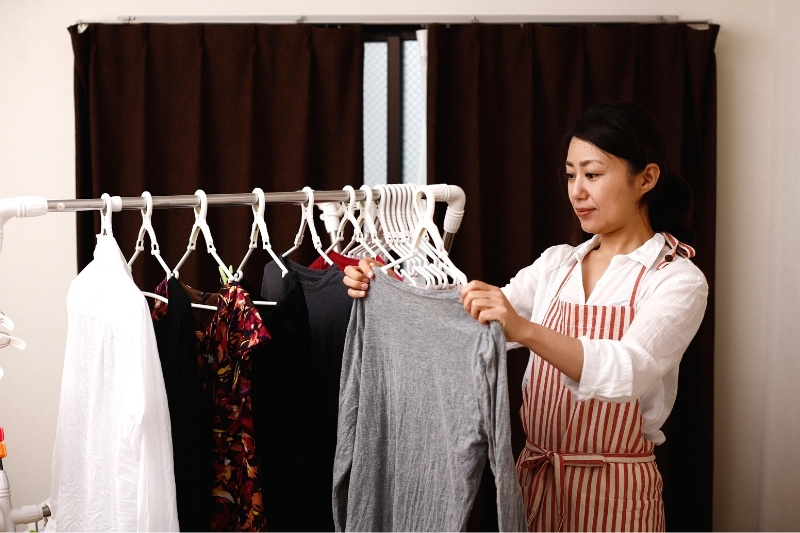Drying laundry can be a pain if you don’t have an outdoor space or a tumble dryer. If you share a house or flat with other people, you might not have any other option than to dry your clothes in the bedroom.
However, is this a good idea?
Drying clothes inside is something that we’ve all done or will have to do at some stage.
While moisture levels in the home will increase when you do this, it’s okay to dry clothes indoors (on heated airers and clothes horses, for example), provided you’ve put measures in place to manage the moisture.
If you fail to do so, mould and dampness will have free-reign and could cause havoc.
In general, unless you really have no other choice, you should always dry your wet laundry in areas that you don’t spend much time in.
Keeping moisture-filled laundry in your living spaces doesn’t just encourage mould and dampness, it can also lead to respiratory issues, and wet laundry can be a bit smelly too.
The bedroom is one of the rooms you spend the most time in. Given the fact that wet laundry encourages mould growth, dampness and potential health issues it would be better to keep it out of a room you spend a lot of time in.
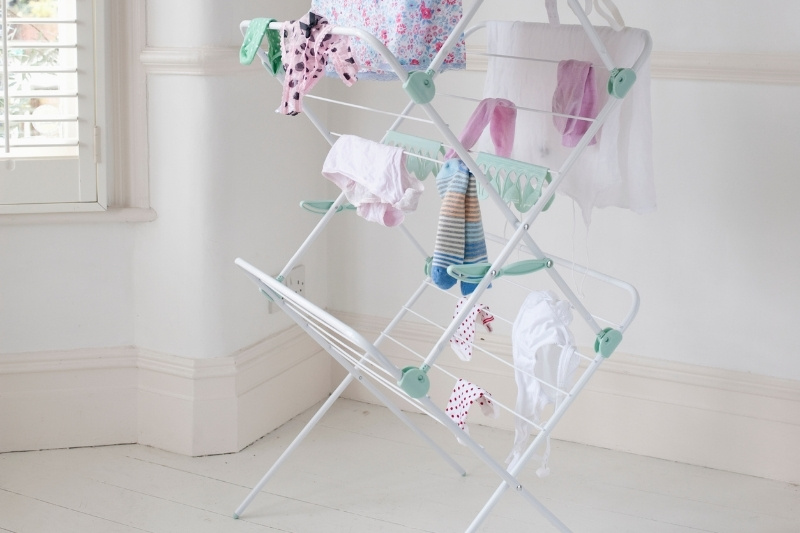
In addition to this, bedrooms are not water-friendly places anyway, and they’re not usually equipped to deal with huge amounts of moisture in the air.
For example, bedrooms rarely come with extractor fans (unlike bathroom), the floor can be carpeted, so it takes a while to dry, and unless the window is always open it won’t be very well ventilated.
Drying laundry in such an ill-equipped environment could enhance your chances of getting a mould infestation.
In turn, this could lead to more serious health complications for the bedroom user, damp could give rise to several structural problems in the bedroom (damage wooden features), and said problems could be costly to put right.
However, you can mitigate some of these problems by practising good drying techniques. In most cases, you need to make sure that the laundry and the space it occupies has excellent ventilation.
This can be ensured by opening plenty of windows and putting a fan on, or by using a dehumidifier to extract moisture from the air.
Find out more below.
Potential Issues with Drying Clothes in the Bedroom
Let’s take a closer look at the potential issues you could face if you choose to dry clothes in your bedroom.
1. Mould

One of the main issues you’ll potentially see if you dry clothes in your bedroom is mould.
According to the Professor David Denning from the National Aspergillosis Centre in Manchester, drying laundry indoors can raise moisture levels in the home by up to 30%.
This, in turn, leads to mould, known as aspergillus fumigatus, growing on walls, ceilings and windows, and undetectable spores getting released into the air and being inhaled by people.
For some people, especially those with underlying respiratory issues, mould can cause allergic reactions, coughing, sneezing and a runny nose.
Dust mites can also start to set up home in your bedroom because you’re creating a humid environment for them to thrive in.
If you have a dust mite infestation in your room, it can worsen your allergies, particularly in those with asthma.
In addition to this, hanging wet clothes up to dry all around your bedroom can also be very smelly.
While you’d think that freshly cleaned laundry would smell great, it isn’t always the case. A horrid damp stench can penetrate the room.
2. Unhealthy air

As mentioned earlier, humid and moisture filled environments give rise to mould growth, and it is this mould that can cause several health-related issues to occur in humans.
One of the main issues is that the aspergillus fumigatus mould can make breathing difficult for those with pre-existing breathing-related problems, like asthma and COPD.
If you have a condition like this, sleeping in a stuffy environment where there’s lots of moisture can escalate the condition.
In addition to this, the spores from the mould can also cause lung problems, weakened immune systems and eczema flare ups in people. All of which can be very painful and upsetting.
Further to this, if you don’t have sufficient air flow in the bedroom when you’re drying your laundry the room can feel quite stuffy and dense. This can trigger breathing issues, itchy eyes, runny nose and coughing in anyone.
It’s also not the type of environment you want to be sleeping in because it’ll be uncomfortable. And this level of discomfort may become unbearable if you’re constantly exposed to it.
Also, as the bedroom is exposed to more moisture, more mould will grow, which means that your immune system will have to work overtime during the day and night to protect the body from impurities in the air. This can be quite tiring on the body and could lead to more serious health problems.
Finally, given the fact that your aim is to dry clothes in the bedroom you may be tempted to switch the heating on to speed up the process.
While the air in the room may feel toasty, the overwhelming moisture plus heat, may make the environment too hot for your body.
In turn, you may get too warm during the night and sleeping may become a problem in the stale and heavy feeling environment.
3. Moisture can damage wood and wallpaper
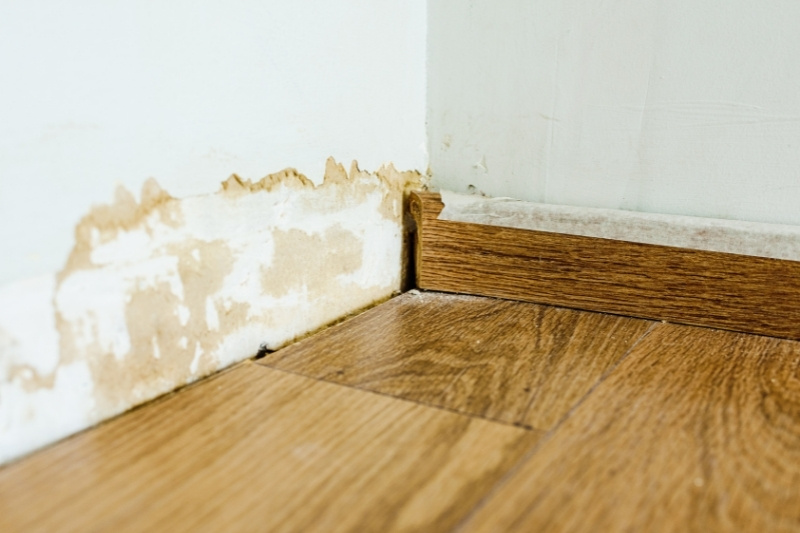
Although the above concerns are some of the most pressing ones, you also need to consider the structural effects drying laundry in your bedroom may have.
The issue with drying laundry in a bedroom setting is that the room generally won’t be equipped to deal with liquid and moisture in the air.
So, you’ll have to put measures in place to mitigate potential problems (open windows/use a dehumidifier).
If you don’t do anything, and you just allow the moisture to fill the room, you could face serious long-term building-related issues.
The main issue is that too much moisture in the air can lead to condensation, and this, in turn, can rot several wooden structures in a bedroom.
For example, exposing wooden window frames, squirting boards and floorboards to water will eventually rot them.
In addition to this, if the ceiling gets too wet, the moisture could find its way into the attic and compromise the wooden structures up there.
Similarly, if you constantly expose your wallpapered walls to moisture, the paper will start to come away from the wall. Also, if your bedroom carpet gets filled with liquid and isn’t dried properly, the floorboards underneath will eventually start to decay.
It can be quite costly to rectify the problems listed above, and it is also dangerous to leave the damages untreated.
Furthermore, too much moisture can cause black mould growth. Of course, you can treat this unsightly mess, but you’ve got to be careful not to damage the walls further. For example, you could easily rip some wallpaper as you clean the mould away.
And finally, mould and dampness can also affect furnishings and their integrity in a bedroom, for example wardrobes and wooden bed frames.
In many circumstances, you can clean and treat the problems. But sometimes items have to be thrown out because they’re too dangerous to have around. Replacing bedroom furniture can be costly.
4. You need to spend money to do it safely

If you’re going to be drying clothes in a bedroom, you’ve got to plan ahead and make sure that you’re using the right drying equipment in the room.
Bedrooms typically aren’t equipped to deal with the vast amount of moisture in the air, so it’s up to you to deal with it.
So, there’ll be an initial cost of buying the correct tools for the job to start off with. For example, getting a heated airer and a dehumidifier.
You may also have to buy mould cleaners and anti-mould paint in order to mitigate potential issues.
If you don’t do any of these things, it’s likely you’ll have trouble with the points listed above. And they’re going to be expensive to put right.
You’ll also need to take into account any potential repair work you may need to do if drying laundry in the bedroom is going to be permanent.
This could be treating pre-existing structural issues (fixing damp on walls and wooden window frames, for example).
Repairing any damaged furnishings (wardrobes and drawers, for example). Or thinking ahead about potential repair costs that could occur.
In a lot of cases, and if you catch the issues early on, you’ll be able to fix the problems yourself. But if you’ve got serious damage in your bedroom you might have to call a professional in to help and this would be costly.
Also, you’ll need to factor in the price of heating your bedroom during the winter and leaving the bedroom window open to encourage airflow.
This doesn’t make sense energy wise because you’re allowing hot air to escape and wasting money. But in terms of ventilation and good drying practice, it’s something that needs to be done.
5. Lack of space

Of course, before you dry clothes in a bedroom you’ve also got to consider how practical this idea is. Bedrooms aren’t always the biggest of spaces, so you need to know how and where exactly you’re going to be drying your wet laundry.
You cannot, for example, leave your clothes lying in heaps on the floor because they won’t dry, the water will work its way into the floorboards, and they’re also a hazard.
In addition to this, if you do invest in drying tools, you’ve got to have sufficient space to move around. It’s not practical to have a large clothes horse in the middle of a bedroom where you could trip over it in the middle of the night.
And of course, if your bedroom isn’t that big, having lots of wet laundry packed into an already busy space, means that air won’t be able to circulate around properly. So, the issues listed above may be magnified in such a tiny space.
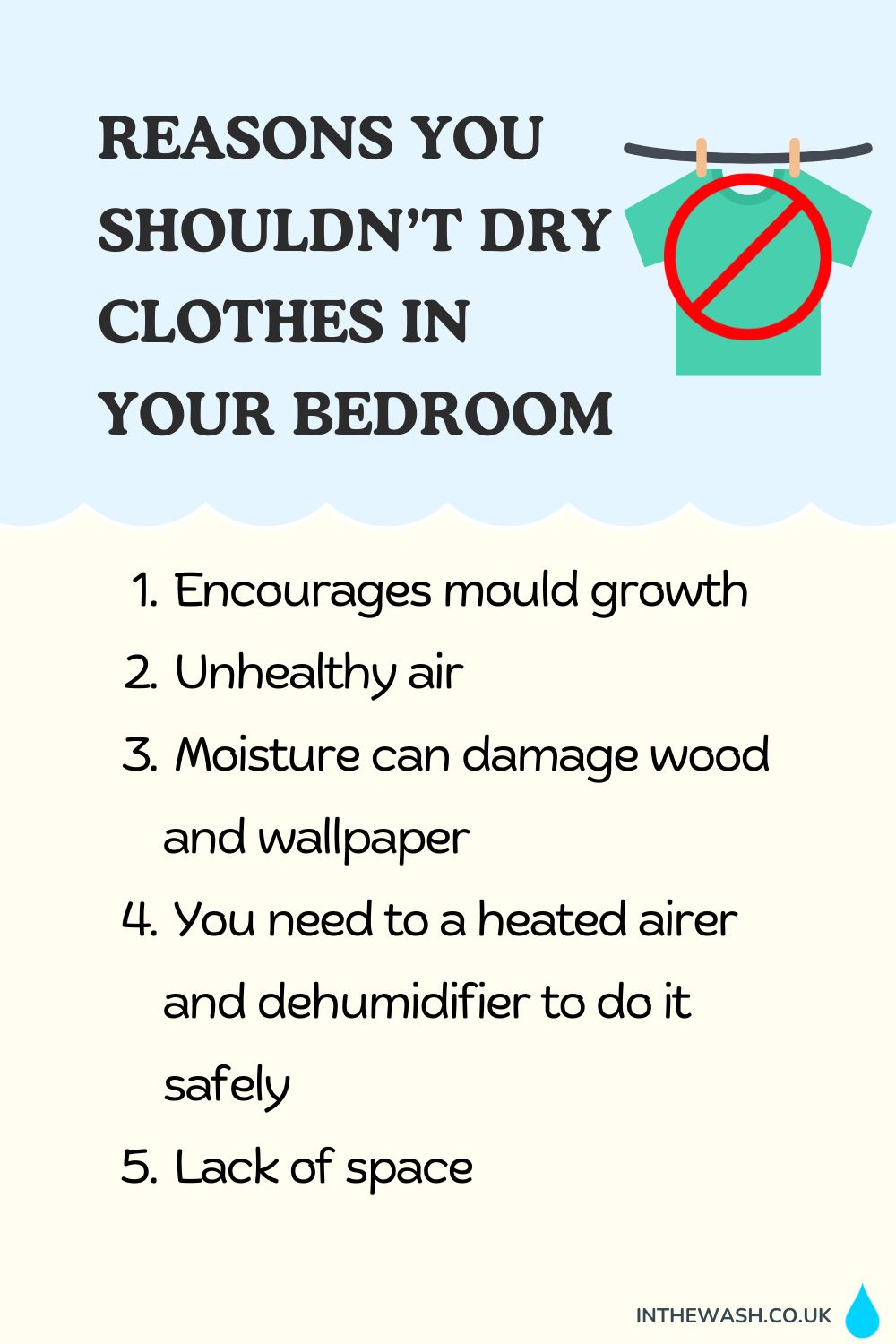
How to Dry Clothes in the Bedroom Safely
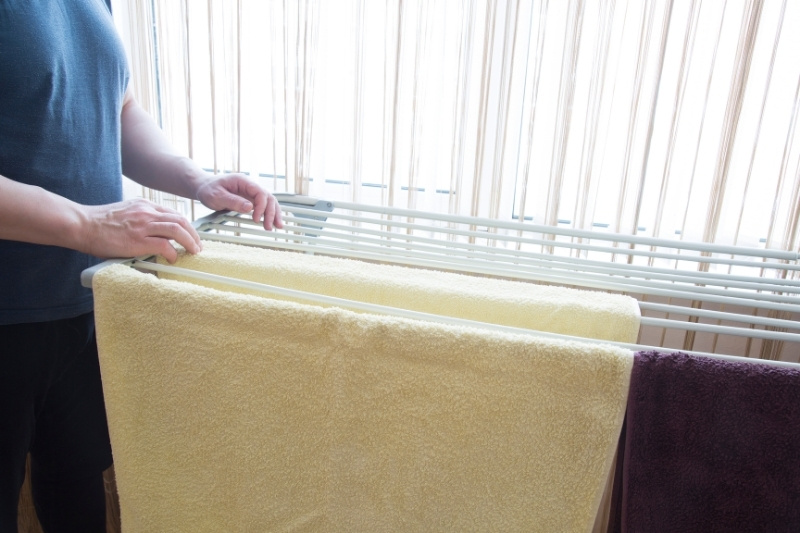
Drying clothes in a bedroom isn’t the best idea in the world. However, if you don’t have any other option you should try and make the best out of the situation.
Try the preventative measures below to limit the amount of mould and damp in your bedroom:
- Ventilation is key. Open plenty of windows and doors, and set a fan up near your wet clothes to move the air about.
- Use a dehumidifier with a specialised laundry setting to extract moisture from the air.
- Clean mould away as soon as possible.
- Use an extractor fan if you have one.
- Make sure clothes are dry before you store them.
- Open the windows as much and as often as possible when drying laundry.
- Invest in the right tools wherever possible to aid the drying process. Purchase a heated airer, for example.
- Allow plenty of natural light into the bedroom.
If there is any way you can tumble dry your clothes or dry them outside, this will always be a better option. You could ask a family member or friend for help, or use a local launderette or laundry service.
Should You Sleep in a Bedroom Where Clothes Are Drying?

There are lots of potential issues with drying clothes in a bedroom, and these problems won’t go away if you decide to sleep in the bedroom with the wet laundry.
You’ll be sleeping in a damp smelling bedroom, and mould could grow and the spores might impact your respiratory system.
Of course, some people manage to dry clothes in their bedrooms without anything bad happening. But it’s worth knowing the potential risks involved.
If you can avoid it, it’s best not to sleep in the same room as wet laundry. However, depending on your living situation you might not have any alternatives.
If you are going to sleep in the same bedroom as your laundry, you should make a conscious effort to ensure that there’s plenty of air going in and out of the bedroom.
Open the window and use a fan wherever possible to circulate the air. If you have one, use a dehumidifier to collect additional moisture from the bedroom.
This should limit the amount of moisture in the air and should prevent serious issues from occurring.
Risks are lower in the summer months if you can put clothes near a sunny window and keep the window open. In the winter it’s harder to dry clothes safely since it might be too cold to open the windows and clothes will dry more slowly.

Bethan has a passion for exploring, reading, cooking and gardening! When she’s not creating culinary delights for her family, she’s concocting potions to keep her house clean!
